Leaving for exile – the so-called southern route and the Middle East
After the attack on Poland, those who were leaving to exile to fight for the freedom of Czechoslovakia were forced to use the so-called southern route. It meant to pass through the Slovak state, former part of Czechoslovakia, and Hungary, representatives of which did not like the escapees and the reasons why they were leaving. When being arrested, they were risking jail and extradition back to the Protectorate, which meant being handed over to the Gestapo and sometimes killed. The first safe country along the route was Yugoslavia. From there, they would continue via Turkey, Libanon and other Middle East countries to France. Prisoners from the Soviet Union, who were interned there after withdrawing from defeated Poland, would be also sent via the Middle East. After the fall of France, those who were in Beirut were transported to Palestine. The first members of the Czechoslovak unit in Palestine were recruited from among these people. The southern route itself was cut off by the German invasion of Yugoslavia and Greece.
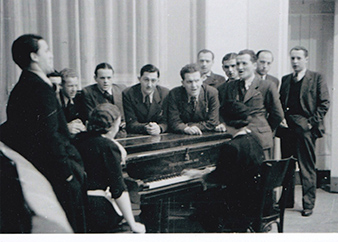 |
 |
|
Stop in Belgrade. Zastávka v Belehradu. From the left on the picture: Na fotografii zleva: Václav BROŽÍK (Parachutist instructor in the USSR/ V SSSR instruktor parašutistu), Vladimír NEDVED, Václav ŽDÍMAL (KIA 29th June 1944/29. cervna 1944), Ladislav KOCOUREK (KIA 17th March/17. brezna 1943), Josef OTISK (commander of the Wolfram paratroop unit, awarded the Order of the British Empire/velitel výsadku Wolfram, držitel rádu MBE). Archiv Tomáše Jambora. |
|
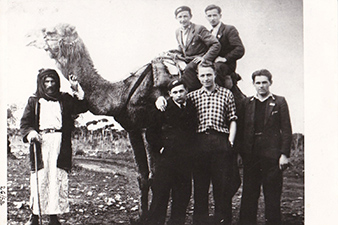 |
|
|
Beirut, February 5th, 1940. At the top Rudolf HUSÁR (radar operator of 68 Night Fighter Squadron) and Josef JURÍCEK (fitter, 310 (Czechoslovak) Squadron), standing: Jaroslav LANCÍK (air gunner, 311 (Czechoslovak) Squadron, KIA, July 2nd, 1941), Rudolf MAŠEK (air gunner, 311 (Czechoslovak) Squadron, KIA, January 17th, 1942), unknown. Archive of Tomáš Jambor. |
Passport page of Arnošt VALENTA, illustrating his route to join the resistance. |
The members of the Czechoslovak military unit in the Middle East took their first oath already on 28th July 1940. However, in September of the same year, volunteers who enrol in the newly established Czechoslovak squadrons in RAF in Great Britain left it. There were twenty five of them. They sailed on 10th September 1940, i.e. exactly on the day of the first combat mission of 311 (Czechoslovak) Squadron.
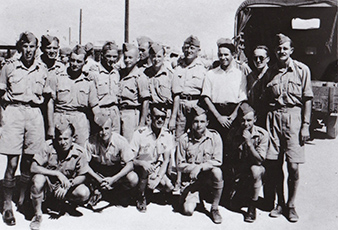 |
 |
|
First transport of volunteers, future RAF members. Standing: first from the left Metodej ŠEBELA (pilot, 311 (Czechoslovak) Squadron, KIA, 18th November 1943), sixth from the left Jan CEKAL (pilot, 311 (Czechoslovak) Squadron), eight from the left Milan MALÝ (pilot, 312 (Czechoslovak) Squadron), tenth from the left Karel ŠTEFÁNEK (mechanic, later a pilot, 313 (Czechoslovak) Squadron), eleventh from the left Stanislav TOCAUER (pilot, 312 (Czechoslovak) Squadron), sitting: fourth from the left František HAMBÁLEK (mechanic, 311 (Czechoslovak) Squadron) |
Czechoslovak soldiers, together with Poles, were initially guarding German and Italian POW. |
More than two months later the Czechoslovak Infantry Battalion No 11 East was founded. Until March 1941, its soldiers were in training, after which they were transported to a suburb of Alexandria where they were, together with Polish units, guarding German and Italian prisoners of war.
In May of the same year, the unit was sent to the front, however, it was mostly performing guard services. It was not until June when it became involved in combat and successfully fought in Syria with the French Foreign Legion. When the fight ended, some of the Czechoslovak legionaries from the French Foreign Legion transferred to the Czechoslovak Infantry Battalion No 11 East. Prior to our soldiers being sent to the besieged Tobruk in October 1941, they were, once again, engaged in a guard service. Once in Tobruk, they fought alongside Poles and Australians until April 1942, when the Czechoslovak Infantry Battalion No 11 East was withdrawn.
 |
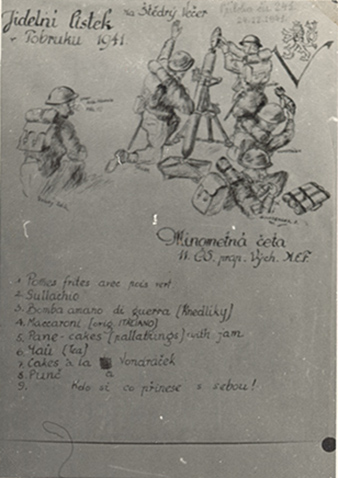 |
|
Tobruk Harbour. 1941. Zdenek Hurt collection |
Christmas Eve dinner menu of the Czechoslovak field kitchen in Tobruk, 24th December 1941 |
A month later, it was dissolved and reorganized into the Czechoslovak 200 Light Anti-aircraft Regiment, which was protecting the ports and crude oil refinery in Palestine and Lebanon. On 24th June 1942, the Czechoslovak Military Mission published an appeal to join the Czechoslovak Air Force units in Great Britain. Upon a decision of the test committee, 171 of volunteers sailed in October of that year. This group arrived to Great Britain on 1st January, 1943. After training, most of its members were sent in various positions to Czechoslovak squadrons. Those who stayed with the Czechoslovak 200 Light Anti-aircraft Regiment returned to Tobruk on New Year’s Eve of 1942. At the end, the Czechoslovak 200 Light Anti-aircraft Regiment was dissolved on 12th June, 1943 and most of its members sailed to Great Britain, where they became members of various Czechoslovak ground forces.
Nevertheless, the stated routes were not the only routes Czechoslovak citizens were using in order to join the exile army. Some of them were mobilized, while others were employed abroad even prior to the beginning of World War II, not only in France and Great Britain, but also in some very exotic countries. One of the companies that was intentionally sending its employees to join the resistance was Bata. Jewish escapees were joining the military units as well. Yet other members of the (Czechoslovak) squadrons RAF were recruited from the Czechoslovak ground forces in Great Britain. Former members of the international brigades in Spain as well as escapees from the so-called Governmental Army also served in RAF. The Governmental Army was an army that the Nazis permitted to be established in the Protectorate of Bohemia and Moravia. However, the Nazis did not trust its members and they move them to Italy, where they used them for labour and from where some of them would escape to join the resistance.
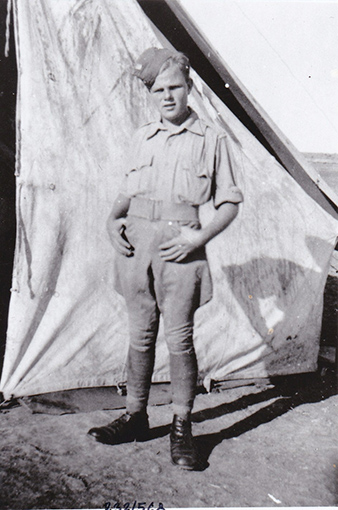 |

Czechoslovak pilots on their way to Great Britain were often a subject of interest of journalists. The Gestapo was certainly pleased about it, since it was thus able to identify names of other escapees. The article says: “Aviation heroes. A group of Czechoslovak pilots, now temporarily in the capital, after they gallantly fought overseas, especially in the memorable battle of Tobruk, where they heroically contributed to the defeat of the Nazi air force. In the group we can see air force lieutenants: Ladislav SNÍDAL (navigator, RCAF and 311 (Czechoslovak) Squadron), Vladimír VANEK, Vilém KAUDERS (navigator, 311 (Czechoslovak) Squadron), Bohumír KRÉZEK (navigator RCAF and 311 (Czechoslovak) Squadron), Eduard WICHTA (navigator, RCAF and 311 (Czechoslovak) Squadron), Miroslav SOBOTA (navigator, 311 (Czechoslovak) Squadron), Konrád ŠMAHEL, Karel ŠTEPÁN (navigator 311 (Czechoslovak) Squadron), Robert KOBLOVSKÝ (navigator 311 (Czechoslovak) Squadron), Josef HOREJŠÍ (pilot, 311 (Czechoslovak) Squadron) a Arnošt ŠVERMA (pilot, 311 (Czechoslovak) Squadron).“ Archiv Lubomíra Úlehly. |
|
Milan Malý, defender of Tobruk, later a pilot with 312 (Czechoslovak) Squadron. Archive of Tomáš Jambor. |
Curated by Filip Procházka living history group 276th Sqdn. (reenacted) RAF